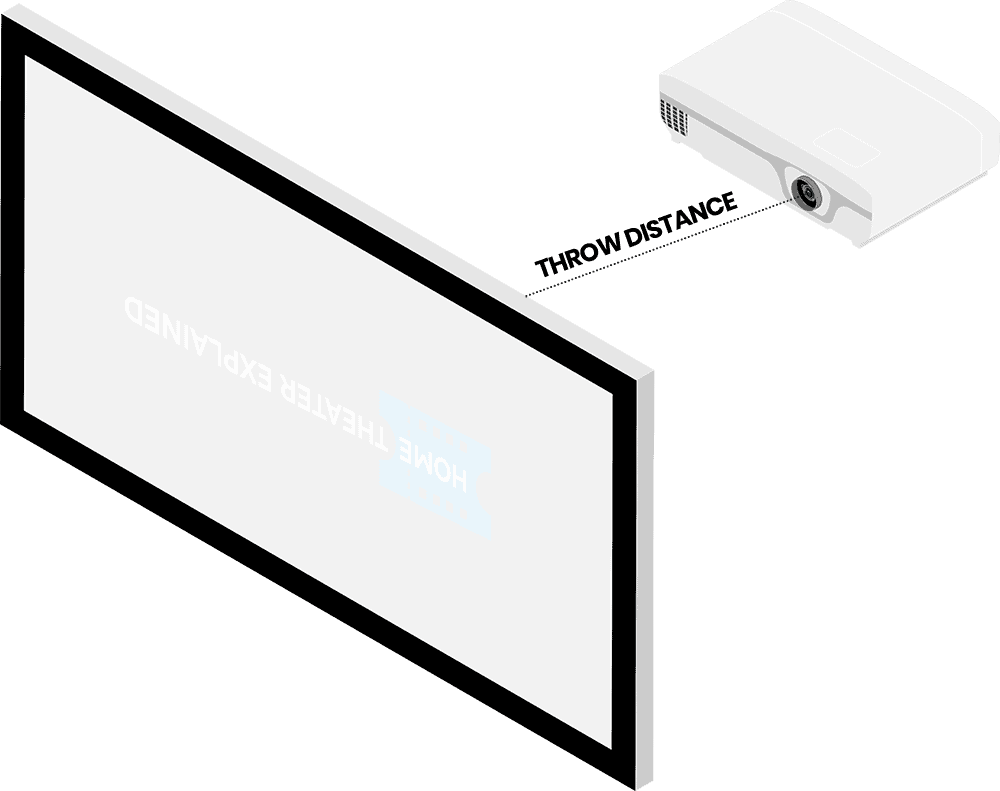If you're in the market for a projector, you will have noticed how the specifications vary from one model to the next. One vital criterion should be the throw distance; how near or far the projector should be from the screen to create a sharp image.
Short throw projectors are ideal in smaller spaces, such as offices, bedrooms, and living rooms. They can fill 100" screens from just a few feet away. Ultra-short throw projectors need only be a few inches away from the screen to cast high-resolution images.
Long-throw projectors cast larger images from greater distances away; this makes them ideal for conference rooms, halls, and large venues.
The biggest determining factor between the two is the lens; its quality and its construction. Long-throw projectors rely on simpler lenses; they are typically the more affordable of the devices.

Short throw projectors require minimal installation and set-up time takes minutes, about the same time it takes for a new television. It makes them ideal for people new to projectors.
They sit directly in front of the screen; there is no need for a professional ceiling installation.
Long HDMI cables are expensive; short throw projectors only need the regular lead supplied.
Short throw projectors often have a laser light source, making them very bright, adding luminescence to the images. Lasers typically last around 20,000 hours. By comparison, lamp-based projectors have a 2500 – 4000 hour life expectancy.
Some of the additional cost of short-throw projectors is recouped against not having the expense of regular bulb changes.
Some ultra-short-throw projectors are marketed as TV replacements; they are pre-loaded with Smart TV OS. Some have voice-activated remote controls.
High-end models with internet connectivity provide real-time system updates.
ALR screens reflect light from below and reject light from above. The unique positioning of the short throw projector ensures it rejects more light, especially that from the ceiling. Greater contrast and brightness supplies vivid pictures with superb clarity.
Light is a projector's enemy, but short-throw models are best-suited for use in rooms with windows and ambient light.
The models with speakers in the front are ideal for living rooms with no surround-sound system.
If someone gets up to get a drink, the placement of the projector means there are no shadows cast on the screen.

Installing a long throw projector is a precise science, ensuring the optimum size and quality picture; throw distance should be accurate. Most long-throw models work best when ceiling mounted; incorrect measurements adversely affect the image. If the throw distance is too short, the images are too small; too far away, the image is too big for the screen.
To calculate throw distance, refer to the projector's handbook; if it shows a ratio such as 1.3, the throw should be 1.3 x the width of the screen in inches. It must be accurate, especially in models where there is no zoom option to offer flexibility.
If your projector has a varied throw ratio such as 1.5 – 2.25, precision isn't quite so important. For a screen width of 87”, the center of the lens should be 130.5 – 190.75” away.
Long-throw projectors work best in large venues such as cinemas, halls, and assembly rooms. They work well for presentations and movie nights where there is no limit to screen size.
The projector needs to be at least 6ft from the screen, but the further away it can go, the bigger picture it can project. Long-throw devices are capable of 300" images in 4K, HDR, and HD – bright, detailed, and are superbly saturated.
Long-throw devices are invariably more affordable than their short-throw counterparts. They are cheaper to build, mostly because they don't use the same high-quality glass lenses.
There are 3-main types of a long-throw projector, the technology in each is different and directly affects the price:
Throw distance is calculated by the ratio of the projection distance (shown on the device) multiplied by the projection width (horizontal screen width)
| TYPE | PROJECTION DISTANCE RATIO | THROW DISTANCE |
| Long Throw | 2.5:1 | 16.4ft or more |
| Standard Throw | 1.2 to 1.5:1 | 4.9 to 16.4ft |
| Short Throw | 0.6 to 1.2:1 | 2.3 to 2.9ft |
| Ultra-Short Throw | Less than 0.6:1 | Less than 1 to 2.3ft |
This is a guide for the recommended distance between the center of the projection lens and the center of the screen.
There is one main consideration when choosing between short throw and long throw - room size. Lecture halls and large classrooms need a long throw device, where-as short throw projectors are suited to smaller rooms and living spaces.
There are projectors of every throw distance to suit many budgets, all of which can create images in the highest resolution.
